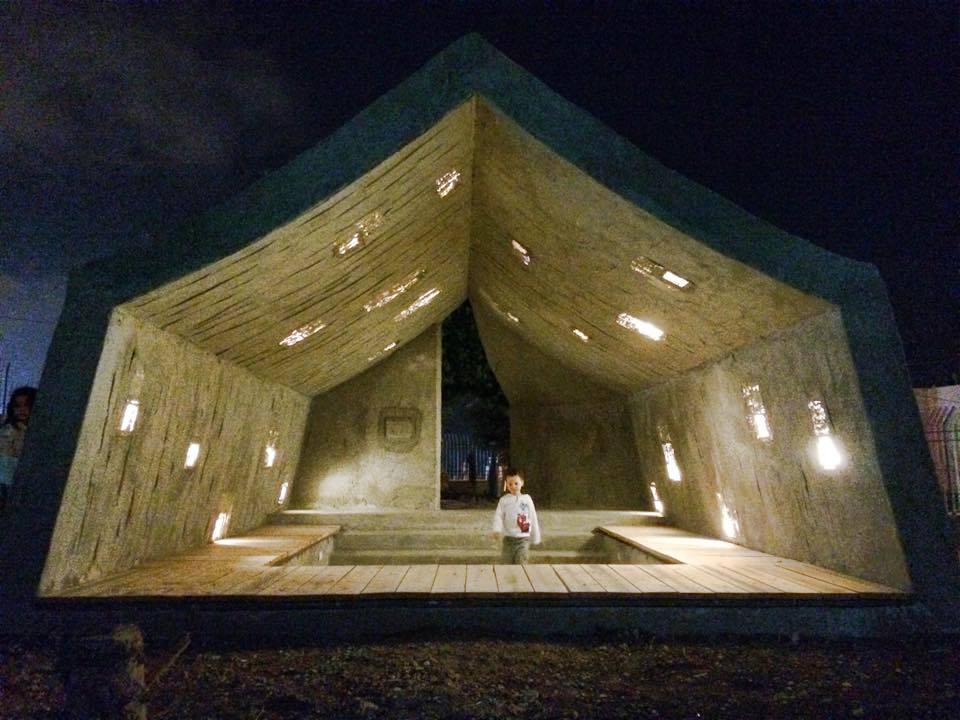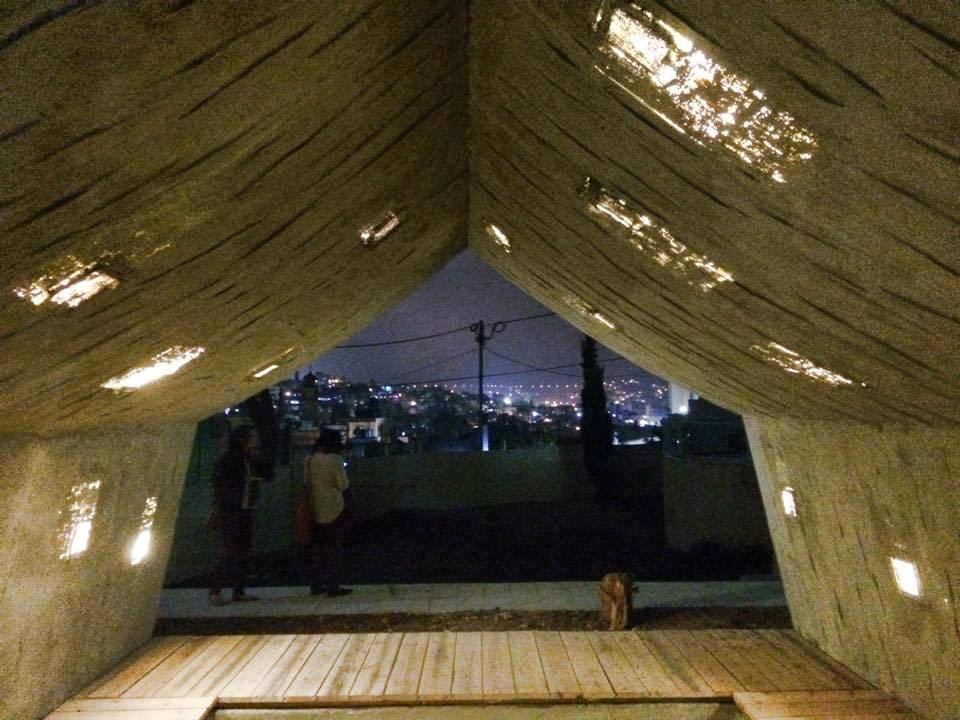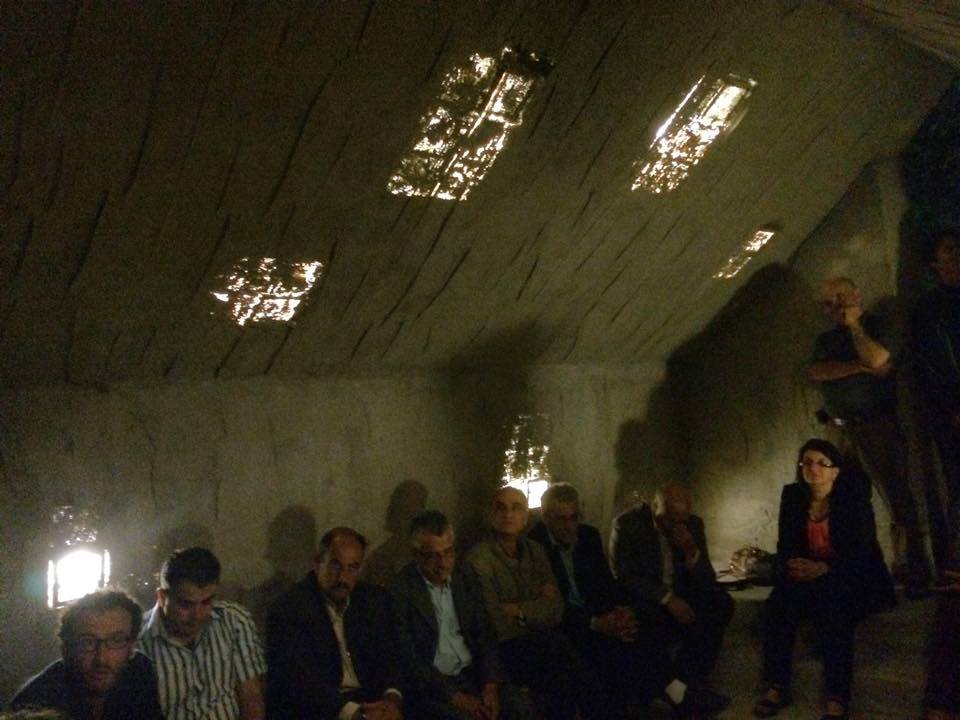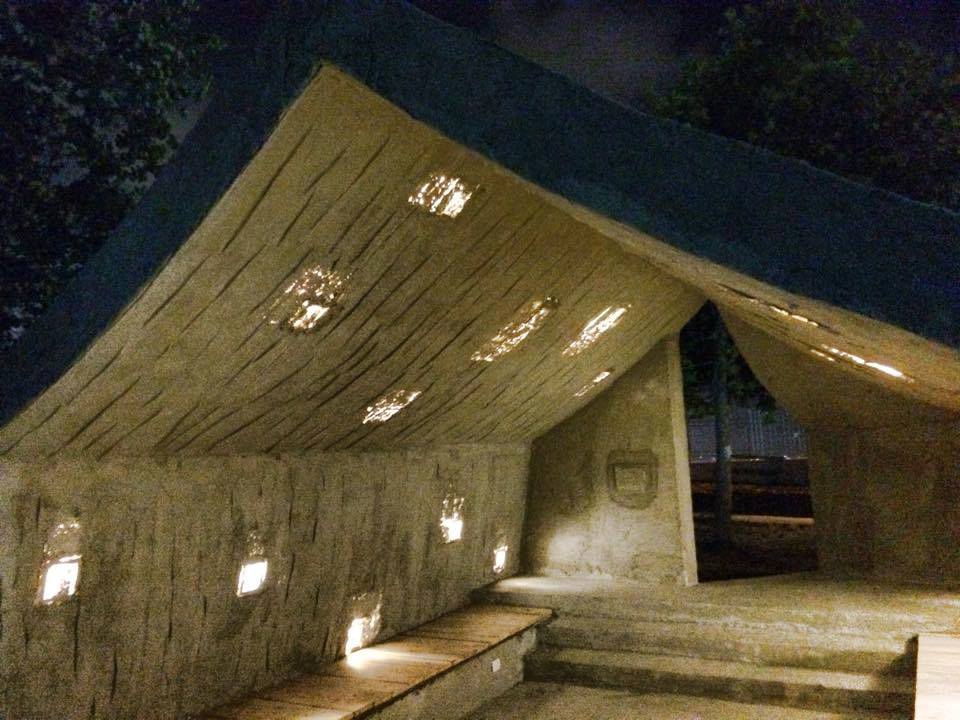
A newly constructed concrete tent in the Duheisha refugee camp south of Bethlehem in the West Bank. (MaanImages/Alex Shams)
BETHLEHEM (Ma’an) — Bethlehem’s Duheisha refugee camp on Friday officially became home to a new community center housed in an unexpected but albeit quite familiar structure for local residents: a refugee tent constructed entirely out of concrete and mesh.
The concrete tent is located in the Edward Said Garden of the al-Feniq cultural center near the camp, and has been dubbed by its creators as a “gathering space for communal learning.”
The design pays homage to the history of camp’s 15,000 residents by recalling their ancestors’ struggle after they were forced to flee their homes in villages west of Jerusalem in 1948 by Zionist militias, a part of the total of approximately 750,000 Palestinians who were forced from their homes in what many historians have called “ethnic cleansing.”
At the same time, however, the structure challenges the idea of the temporariness of refugee camps, highlighting their increasing permanence and the importance of the camp’s history of struggle and resistance since 1948 by “embracing the contradictions of an architectural form that emerges from exile.”
To do so, the structure’s creators insist, does not detract from refugees’ right to return to their original villages inside what is now Israel. Instead, they say, it emphasizes the strength of the community and culture that have been formed as a result of nearly seven decades in exile, as well as their continued insistence on reclaiming their stolen homes and land.

‘It reveals the contradictions in which we live’
The concrete tent is the brainchild of Campus in Camps, a year-long “experimental education program” for refugee youths from across the West Bank that focuses on issues related to urbanism, space, and lived experience in the refugee camps. The project is affiliated with DAAR, the Decolonizing Architecture Art Residency based in nearby Beit Sahour.
Ishaq Albarbary, a participant in Campus in Camps from Bethlehem’s Duheisha refugee camp, told the crowd assembled at the structure’s inauguration after a collective iftar on Friday that the concrete tent was a result of three years of “discussion, reflection, and of challenging ourselves.”
“The nature of our work at Campus in Camps is to connect the practical and the theoretical,” he said. “At the same time, we don’t want the discussion to always be internal between ourselves, and so we decided to something material to open a space for discussion about and for the society in which we live.
“The concrete tent is not being presented as a solution. On the contrary, it reveals the contradictions we live in,” he added, noting that they hoped it would be used for meetings, discussions, and leisure.Construction of permanent structures in the refugee camps is an ideologically-charged issue for Palestinians, as many refugees see any hint of permanence in their surroundings as a tacit admission that they will not return to the villages their families were expelled from.
Since the camps’ humble start as a collection of UN-donated tents in the late 1940s and early 1950s, however, they have been dramatically transformed. In the years after the establishment of the camps, residents slowly began building mud walls and later adding cinder blocks and eventually cement. Thus while the phrase “refugee camp” often evokes images of temporary tent cities constructed to house displaced people for a limited time, in Palestine and in Palestinian camps in Lebanon, Jordan, and Syria, they have evolved after nearly 70 years into quite permanent concrete jungles, defined by haphazard concrete constructions built along extremely narrow alleys originally laid out to divide the family plots where tents were located.
They have become in many ways an integral part of the urban fabric of the cities they are located in or near, and are famous in Palestinian society for their commitment to armed struggle and resistance to the Israeli occupation.
Despite this, residents hold on dearly to the right of return to their original villages and to leave the refugee camps they live in. The walls of camp streets are decorated not only with the usual political graffiti and murals so common in Palestinian cities, but also with elaborate paintings and images of the residents’ original villages as well as signs commemorating them.

‘The concrete tent has become part of our culture’
The contradiction between temporariness and permanence defines refugee life for Palestinians today, as their insistence on the former despite increasing fears of the latter informs political discussions as well as strategy.
But the creators of the concrete tent argue that the recognition of these two contradictory states does not necessarily have to mean ignoring the complex, difficult, and often beautiful worlds that refugees have created in the years since their exile began.
Sandi Hilal, a Palestinian architect who is also a co-director of DAAR, told the crowd on Friday that residents had in the past been suspicious of attempts to build large infrastructure like community centers and swimming pools for their use.
“They’d always respond, ‘well, we’re going back to our villages anyways,’” she said. “But why don’t we bring the camp back with us, as well as all of the culture that has been produced here?”
“67 years in exile are important. … The concrete tent has become an important part of our culture,” she added.
Alessandro Petti, an Italian architect and the other co-director of DAAR, told the crowd that they hoped to emphasize through the structure that “claiming the right of return does not dismiss the reality of life in exile and what has been achieved in the camps.”
“The fact that the camp is not made anymore of tents should not necessarily be seen as giving up on the right of return. In fact, it is the opposite, as it has made the community and the social fabric of the community stronger.”
“The best way for us to represent that was to link the idea of the tent that was originally built after the Nakba and then the way people were forced to adapt to situation but in doing this, never giving up or normalizing their situation.” Abu Khalil, a local leader and representative for refugee issues, connected the structure to the increasing reality of refugee life for millions across the Arab World, noting that the Palestinian experience of exile was a now a reality for a growing number of people from other Arab countries as well.
“The concrete tent connects the temporary and the permanent,” he told the crowd, adding how the “surrealistic” structure reflects how deeply the understanding of exile is a part of the upbringing of any refugee child.
While the concrete tent is meant to memorialize the Palestinian refugee experience and to celebrate the diverse forms of architecture and culture that have evolved since the exile of 1948, Abu Khalil noted that the ongoing conflicts in Syria, Lebanon, Iraq, Libya, and elsewhere lend the structure an even broader resonance.
“I am afraid that this will become a permanent reality for the Arab World, as it has become for us,” he added in his closing remarks.Indeed, the concrete tent not only embodies the contradiction between permanence and temporariness, but also that between the realities of the past and the possibilities of the future.
Whether the tent will be embraced by Duheisha’s local residents remains to be seen, but its symbolic location — on a hill at the peak of the hill that the camp expands across — makes it a commanding place from which to consider the contradictions of modern Palestinian life, and the challenges facing the region as a whole.



